20+ Sample Weekly Work Schedule
-
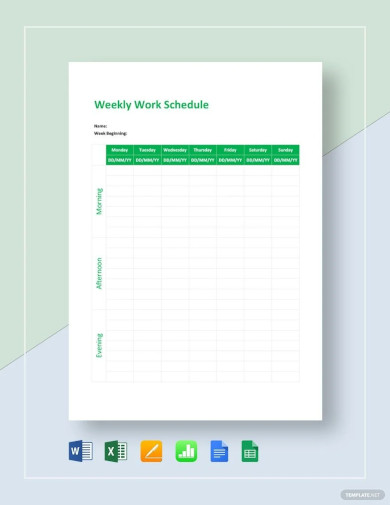
Weekly Work Schedule
download now -
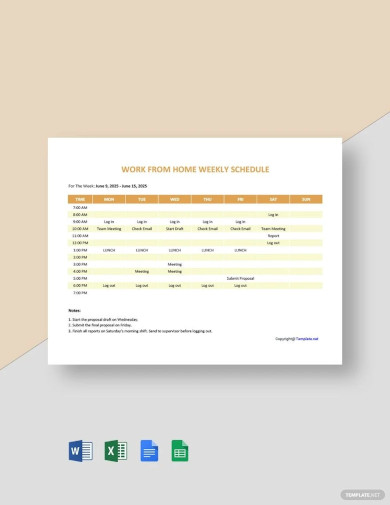
Work From Home Weekly Schedule
download now -
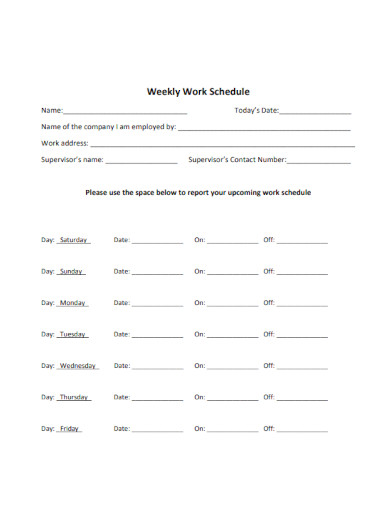
Sample Weekly Work Schedule
download now -
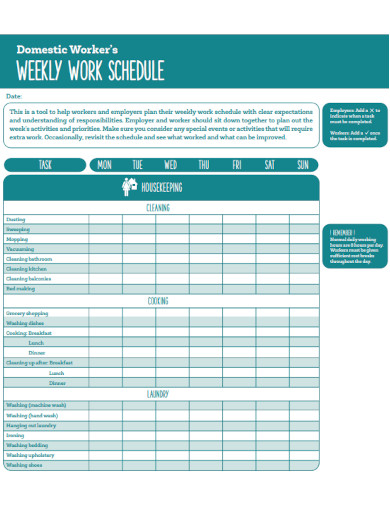
Workers Weekly Work Schedule
download now -

Printable Weekly Work Schedule
download now -

Bi Weekly Work Schedule
download now -
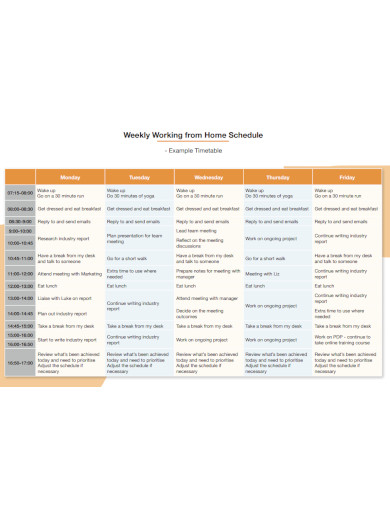
Weekly Working from Home Schedule
download now -
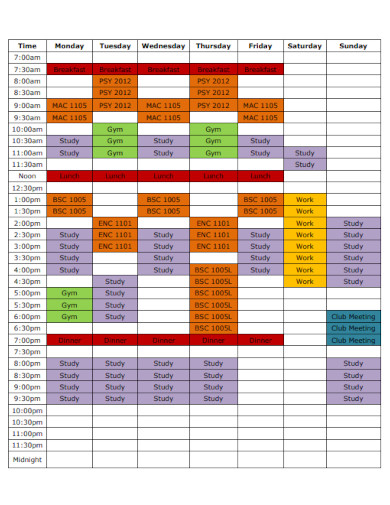
Basic Weekly Work Schedule
download now -
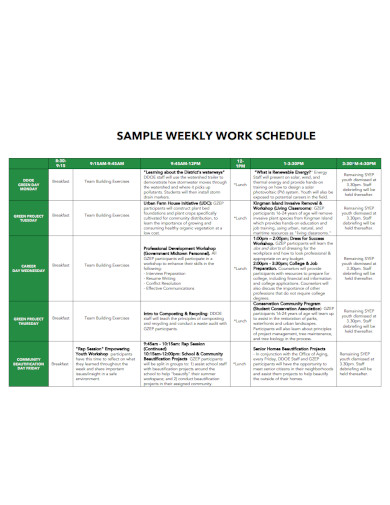
Weekly Work Schedule Example
download now -
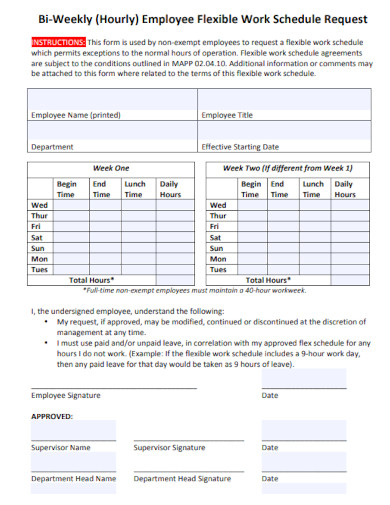
Employee Weekly Work Schedule
download now -
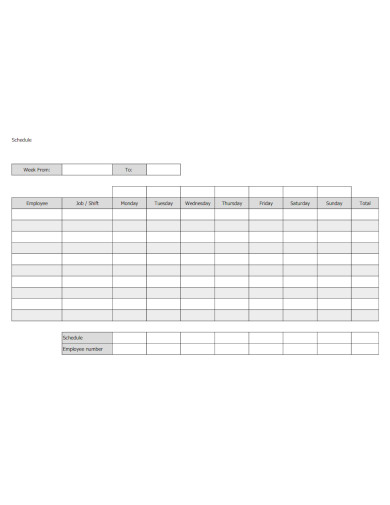
Simple Weekly Work Schedule
download now -
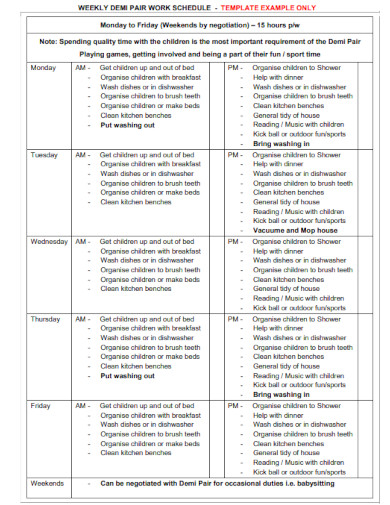
Student Weekly Work Schedule
download now -

Weekly Work Time Schedule
download now -

Weekly Work Schedule Planner
download now -

Semester Weekly Work Schedule
download now -
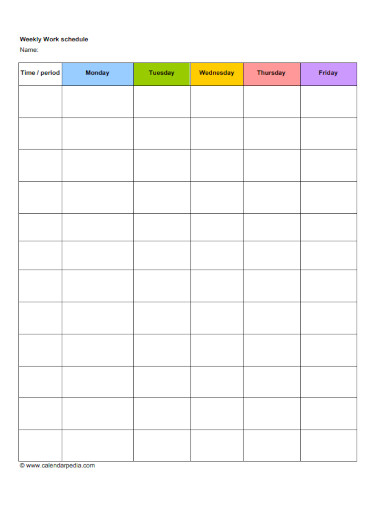
School Weekly Work Schedule
download now -

Fillable Weekly Work Schedule
download now -
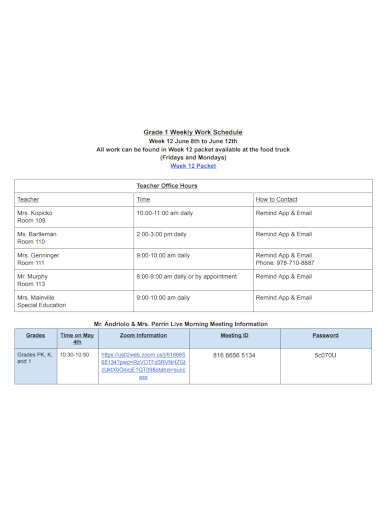
Grade 1 Weekly Work Schedule
download now -
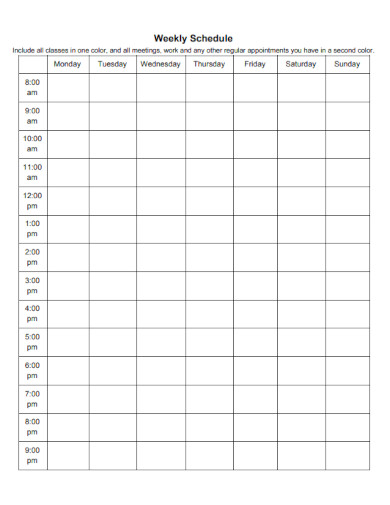
Weekly Work Meetings Schedule
download now -
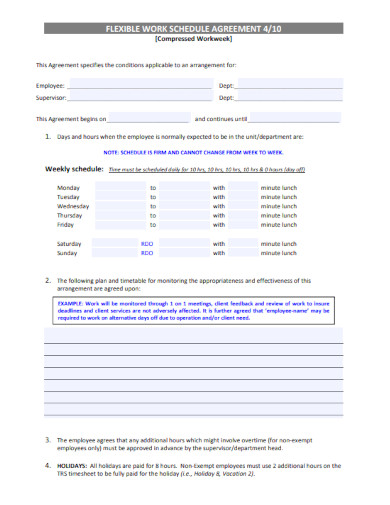
Weekly Work Schedule Agreement
download now -
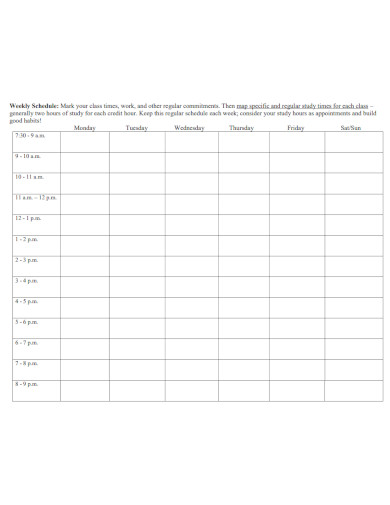
Editable Weekly Work Schedule
download now
FREE Weekly Work Schedule s to Download
20+ Sample Weekly Work Schedule
What Is a Weekly Work Schedule?
Benefits of a Weekly Schedule
Types of Work Schedules
How to Make a Work Schedule
FAQs
What are some prevalent scheduling obstacles?
How can I reduce costs by optimizing employee scheduling?
Why is scheduling employees so important?
What Is a Weekly Work Schedule?
A weekly work schedule specifies the hours and days of the week an employee must perform. Work schedules account for the hours each employee is scheduled to work to maintain adequate staffing levels without overworking individuals. Schedules may be reset weekly, monthly, or on a different frequency if posted or made accessible to employees in advance. In specific industries, more than a set schedule is needed. Schedules may vary based on the organization and the employee’s position. Before offering a job to a prospective employee, it is essential to make explicit the expected work schedule. This is especially true for companies implementing flexible work schedules or other less prevalent work scheduling methods.
Benefits of a Weekly Schedule
A weekly work schedule is essential for the orderly completion of daily duties. When you plan your workweek effectively, you can maximize your productivity, keep a healthy work-life balance, and manage your time. Understanding how to construct a workweek plan can enable you to prioritize your tasks list and distinguish between immediate and long-term objectives. Planning is necessary to ensure you remain organized and prepared throughout the workweek. Consider the following advantages of workweek planning:
Types of Work Schedules
Before we commence, we must recognize that many of these work schedule types share similarities. Each term may refer to a variation in the number of days or hours performed. Due to these similarities and differences, you can combine different work schedules to construct your custom schedule. For instance, you could combine terms to create a fixed seasonal part-time morning shift or a full-time rotating on-call shift. It depends entirely on your organization’s needs and your workforce’s availability.
1. Standard
The standard work schedule is so prevalent that most employees are already accustomed to working those hours. This is one of the most convenient schedules for employers to work into a 24-hour day. And because most scheduling applications are designed around this work day, you do not need to modify your software to accommodate an alternative work schedule.
2. Fixed
Fixed is similar to the regular work schedule, with set days and hours, but it can also refer to alternative work hours. A fixed schedule facilitates long-term planning and simplifies labour cost estimation for employers. Work hours are set from day to day, week to week, and month to month, which makes creating the schedule much more accessible. With a fixed schedule, you do not need to modify your standard template whenever you create a new work schedule.
3. Full-Time
Full-time employment provides employers and employees with predictability and stability. When building a team of full-time employees, locating someone to work overtime can be difficult and expensive. With all full-time employees, you may face a situation in which you need a few additional hours of work but can’t find volunteers, don’t want to pay overtime, and need more work to justify hiring a new employee.
4. Part-Time
A part-time work schedule consists of fewer hours than a full-time schedule. Employees may only work two or three days per week and cannot perform the standard eight hours per day due to the reduced hours. This type of schedule works well for some businesses but can be problematic for others. Administrators must consider a more significant number of individuals when creating a plan for a team of part-time employees. This is only sometimes a negative aspect, but it can make sifting through availability difficult.
How to Make a Work Schedule
Every manager desires a productive work schedule. Unfortunately, this is not the case regarding actual achievement, even though technology facilitates expediting the process and achieving first-time accuracy. Creating an employee work schedule target that makes everyone content can be impossible for managers. In organizations of any size with variable shifts, creating a target weekly work schedule is a significant headache for managers. It takes work to balance the business’s requirements and the employees’ needs while also developing a streamlined process for successfully scheduling the company. If you’re intrigued, here are some suggestions for what to do before creating a work schedule.
1. Consider your staffing levels and availability
To effectively schedule employees, you must have a handle on staff availability. Reviewing your time and attendance sheets can reveal the typical working hours of your team during a given period. Also, you must determine when your group prefers to be scheduled. Using a scheduling application, employees can select their regular shifts or submit for open shifts. Depending on their circumstances, your employees may choose to work in the morning, at night, during the week, or on the weekends. Occasionally, employees will be unavailable due to personal obligations outside of work, such as increased childcare responsibilities.
2. Create a Chart of Availability
In addition to knowing who is unavailable, it is essential to have a system for tracking who is available for additional work. If you know who is open, you can fill in any voids caused by last-minute schedule changes. With so many households affected by layoffs, reductions, and unemployment, many of your employees will appreciate the opportunity to earn extra money. Prioritizing your team’s scheduling preferences increases employee satisfaction and retention. Create and keep a list of these employees and their availability so that you can offer them additional duties as needed. This also makes it simple to know who to contact if your schedule must be abruptly altered due to illness or an emergency.
3. Follow Local Regulations and Rules
Ensure you know any local laws or regulations that may impact your ability to schedule staff before you construct your final schedule. There are federal, state, and local regulations regarding mandatory breaks, overtime scheduling, overtime pay, and holidays for employees. In some jurisdictions, for instance, you must pay personnel to double-time if they exceed a certain number of hours daily. Additional consideration must be given to predictive scheduling regulations.
4. Distribute the Schedule Quickly
Predictive scheduling laws also necessitate planning. For instance, you must inform employees seven to fourteen days before their anticipated schedules. It is preferable to publish your schedule in advance so everyone is aware of it, even if circumstances change. A scheduling application is an efficient method for keeping this information current and accessible to all parties. It also eliminates the need to manually print, post, or email schedules, which increases the likelihood that an employee will miss them.
5. Establish a Method of Team-Wide Communication
If you want satisfied employees, keep them informed of your reasoning. Inform them when you are scheduling additional staff due to an anticipated increase in sales — for example, during the holidays — or when you are scaling back because you anticipate a decrease in sales. And if you give existing employees first refusal on new schedules, your team must also be informed. This method eliminates confusion and enables you to schedule employees fairly and openly. In addition, many shift workers have multiple occupations to make ends meet, so they must also manage various schedules. Informing them of how shifts are assigned can help alleviate some of their tension.
6. Be Prepared for Alternatives
Recent global events have demonstrated that everything can alter in seconds. This is true for both your business and your employees. If a family member becomes ill, a vehicle breaks down, or an urgent home repair arises, employees may need to shift gears rapidly. Employees forced to deal with abrupt changes due to a pandemic, such as staggered school schedules or homeschooling, should be afforded even greater flexibility. Create a procedure that allows you and your team to quickly locate a replacement if you are forced to change your schedule without much notice.
7. Let Workers Find Their Replacements
Giving your employees the responsibility to locate a replacement when they cannot work is another way to reduce your workload. Instead of calling you to let you know they won’t be in today, the employee can email everyone that he is sick and requires a replacement. The team-wide communication network mentioned earlier in the article is the foundation for this procedure. Creating an employee schedule is significantly less stressful for all parties involved if employees can readily access and modify their plans.
FAQs
What are some prevalent scheduling obstacles?
Typical scheduling obstacles include last-minute schedule adjustments and employee availability issues. Utilizing scheduling software that allows for simple adjustments, communicating plainly with employees about the schedule and any changes, and being willing to work with employees to resolve scheduling conflicts can frequently resolve these issues. Developing a consistent scheduling policy that defines scheduling expectations and procedures is also beneficial.
How can I reduce costs by optimizing employee scheduling?
Utilizing data analysis and scheduling software to identify employee productivity patterns and adjust schedules accordingly is one method for optimizing employee scheduling to reduce costs. Cross-training employees to work in multiple areas or roles makes scheduling more flexible and productive. In addition, offering incentives such as compensation or paid time off to employees who can work during off-peak hours can help reduce labour costs while maintaining adequate coverage.
Why is scheduling employees so important?
Scheduling employees is essential because it ensures sufficient employees always work to meet customer demands and complete necessary duties. In addition to reducing labour costs, improving employee satisfaction and productivity, and minimizing scheduling conflicts, a well-planned schedule can also help reduce labour costs.
Developing employee work schedules is a crucial aspect of operating an efficient business. It requires vigilance over multiple variables and problem-solving skills to create schedules that benefit employees and the company. With the preceding information, are you prepared to construct your weekly work schedule? Check out the above templates for your use!
